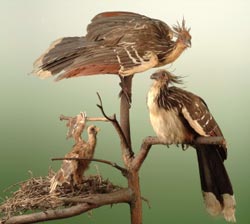Old bird, New World: Did the South American hoatzins originate in Europe?

Hoatzin (Opisthocomus hoazin)<br>©Senckenberg<br>
Studies of the oldest known fossils of Hoatzin ancestors have now shown that these birds existed around 34 million years ago in Europe. Paleornithologists at the Senckenberg Gesellschaft für Naturforschung and Flinders University in Adelaide published their findings this week in the specialist journal “Naturwissenschaften”.
The Hoatzin (Opisthocomus hoazin) is also known as the Stinkbird or Canje Pheasant and today exists only in parts of South America. Its relationship among birds is as unclear as its evolutionary history. Until recently, South America was considered to be the area of origin of these birds.
Then, however, fossils from Africa were described, and new discoveries from Africa and Europe now prove conclusively that hoatzins reached South America from the Old World. A study published in January 2014 in the ornithological journal “The Auk” provided the very first evidence of largely modern Hoatzins from the Miocene (15 million years ago) in Africa.
The oldest fossils attributed to hoatzins were found more than 100 years ago near Paris. But only now have paleornithologists been able to show that these remains belong to ancestors of the modern Hoatzin. The fossils belong to a newly described species, Protoazin parisiensis (“proto-Hoatzin from Paris”). The re-interpretation of these bones indicates that hoatzins lived in Europe as early as the late Eocene, i.e. around 34 million years ago.
“This supports the theory that hoatzins originated in the Old World,” says Dr Gerald Mayr of the Senckenberg Research Institute in Frankfurt. In the opinion of Dr Vanesa De Pietri of Flinders University in Australia, it is “a further impressive example that the South American avian fauna contains numerous relicts that were once much more widespread”.
Most notably, Hoatzins appear to have become extinct in Europe much earlier than in Africa, where the latest fossils were dated as of Miocene age (15 million years ago) and are thus only around half as old. The disappearance of these birds might be connected to a period when numerous new animal species migrated from Asia to Europe during the so-called “Grande Coupure” around 34 million years ago. These included tree-dwelling carnivorous mammals who may have posed a threat to hoatzin nestlings, which are raised in open nests. Because hoatzins can fly short distances only, the adult birds are also easy prey. In Africa, by contrast, similar tree-dwelling carnivorous mammals are shown to have existed much later.
Digestion specialist and climbing artist
The present-day Hoatzin exhibits a special mode of digestion. These herbivores pre-digest their food in this crop before further processing in the stomach and intestines. Similar to the rumen of a cow – a digestive knack that has not been mastered by any other bird. Skeletal features show that Old World hoatzins already had a large crop.
Another special feature of the Hoatzin are the claws on the wings of the chicks, which enable the hatchlings to climb trees.
Publications:
De Pietri, Vanesa L., Mayr, Gerald (2014) Earliest and first Northern Hemispheric hoatzin fossils substantiate Old World origin of “Neotropic endemic”, Naturwissenschaften, © Springer-Verlag Berlin Heidelberg 2014 doi:10.1007/s00114-014-1144-8
Mayr, Gerald (2014) A hoatzin fossil from the middle Miocene of Kenya documents the past occurrence of modern-type Opisthocomiformes in Africa. Auk 131: 55-60.
doi: 10.1642/AUK-13-134.1
Dr. Gerald Mayr
Senckenberg Forschungsinstitut
und Naturmuseum Frankfurt
Sektion Ornithologie
Tel.: 069- 7542 1348
Gerald.Mayr@senckenberg.de
Vanesa L. De Pietri
School of Biological Sciences, Flinders University, Adelaide
Australia
vanesa.depietri@gmail.com
Press Office:
Senckenberg Gesellschaft für Naturforschung
Regina Bartel
Senckenberganlage 25
60325 Frankfurt am Main
Tel.: 069- 7542 1434
regina.bartel@senckenberg.de
Weitere Informationen:
http://www.senckenberg.de/root/index.php?page_id=5210&year=2011&kid=2&id=1828
The first fossil evidence of Hoatzins in Africa was published in October 2011 – also with the participation of Dr Gerald Mayr.
http://www.senckenberg.de/root/index.php?page_id=5210&year=2014&kid=2&id=2960
Media Contact
More Information:
http://www.senckenberg.deAll latest news from the category: Earth Sciences
Earth Sciences (also referred to as Geosciences), which deals with basic issues surrounding our planet, plays a vital role in the area of energy and raw materials supply.
Earth Sciences comprises subjects such as geology, geography, geological informatics, paleontology, mineralogy, petrography, crystallography, geophysics, geodesy, glaciology, cartography, photogrammetry, meteorology and seismology, early-warning systems, earthquake research and polar research.
Newest articles

Silicon Carbide Innovation Alliance to drive industrial-scale semiconductor work
Known for its ability to withstand extreme environments and high voltages, silicon carbide (SiC) is a semiconducting material made up of silicon and carbon atoms arranged into crystals that is…

New SPECT/CT technique shows impressive biomarker identification
…offers increased access for prostate cancer patients. A novel SPECT/CT acquisition method can accurately detect radiopharmaceutical biodistribution in a convenient manner for prostate cancer patients, opening the door for more…

How 3D printers can give robots a soft touch
Soft skin coverings and touch sensors have emerged as a promising feature for robots that are both safer and more intuitive for human interaction, but they are expensive and difficult…




















